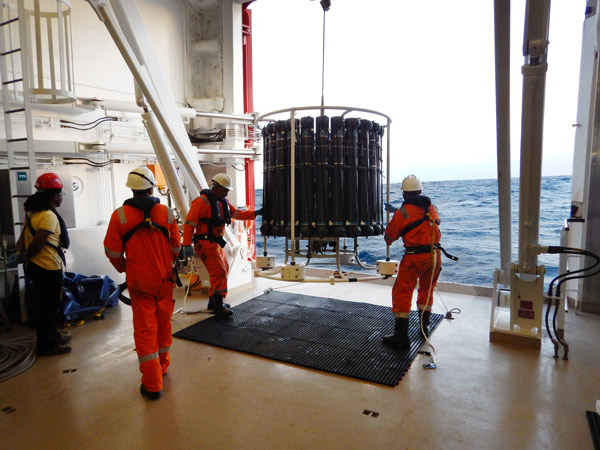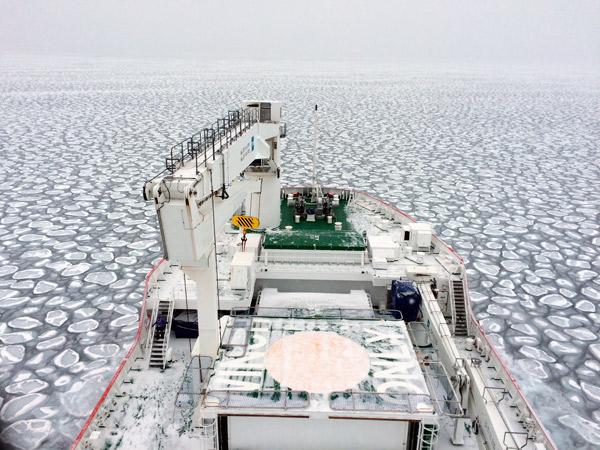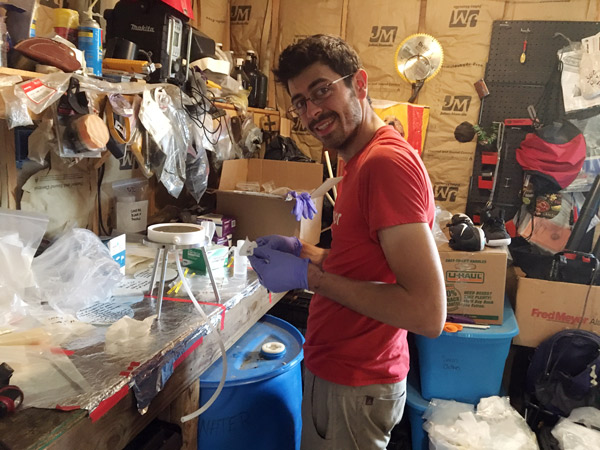Tracing ancient climates with Preston Kemeny
The Southern Ocean encircles Antarctica, a watery ring whose northernmost fringes churn more than 3,000 kilometers (3 × 106 meters) from the South Pole at its center. The ammonia molecule is about 10 quadrillion times smaller: its three hydrogen atoms sit about one angstrom (10-10 meters) from the nitrogen atom at its center.
Hertz Fellow Preston Kemeny (height: about 1.89×100 meters) exists comfortably between these two vastly different scales, but thinks every day about dynamics at both, and everywhere in between. Kemeny is a biogeochemist: his research connects climate, biochemistry, and geophysical processes from ocean currents to erosion. “Earth’s climate is an emergent property of ongoing tectonic changes at Earth’s surface, fundamental chemical physics, and Darwinian evolution,” he explains.
As a PhD student at the California Institute of Technology, Kemeny uses the ratios between different sulfur isotopes to study the movement of protons, electrons, and nutrients though rivers and floodplains over timescales of decades, millennia, and millions of years. But a recently published paper, focused on research from Kemeny’s time as an undergraduate and a research specialist at Princeton University, shows the way these unfathomably large and small dynamics, playing out over seconds and eons, can have a very real effect on the Earth we all live on, right now.
To understand the dynamics of this complex system, Kemeny, working under Princeton’s Daniel Sigman, journeyed to the edge of human knowledge about the most recent Ice Age – and to the edge of the world, with two trips to Antarctica in 2015 and 2016. “Between the ice and the sea lie major mysteries in carbon fluxes, inorganic chemical dynamics, seasonal and annual changes in biological productivity and ecosystem interactions, and the intersection of tectonics and habitability,” says Kemeny. “Walking or sailing into the icy edge of the world captures the imagination as little else can”.
The Southern Ocean’s surface is dominated by the Antarctic Circumpolar Current, driven by strong winds and unhindered by any continents in its west-to-east journey around Antarctica. This strong circulation churns water rich in CO2 and nutrients to the Ocean’s surface, nourishing a thriving summertime marine ecosystem based on phytoplankton and supporting fish, penguins, and whales. But this ecosystem doesn’t consume all the CO2 – much of the gas leaks into the atmosphere, with implications both for our own climate… and the ice ages of years past.
An important record for how nutrients flowed through different ecosystems in the deep past is the mark they leave in sediments formed at the time. Biogeochemists like Kemeny measure the ratio of different isotopes of elements like sulfur and nitrogen to gather clues about how conditions in the past differed from those currently. In the case of the Southern Ocean, the particulars of a complex nitrogen cycle mean that an observed increase the ratio of the heavier Nitrogen-15 to the lighter Nitrogen-14 in fossilized diatoms (a type of algae) indicates that the ecosystem is taking up more nitrate – and more CO2, stemming the “leak” into the atmosphere.
This decrease in the carbon “leaking” out of the Southern Ocean could explain part of the lower greenhouse gas levels characteristic of ice ages, and conversely, why there are more heat-trapping gas during interglacial periods like today. But until recently, the role of seasonal changes in the Southern Ocean nitrogen cycle had been largely overlooked. In a paper published last November in Paleoceanography and Paleoclimatology, Kemeny and his colleagues describe how they developed a numerical model to track these seasonal dynamics. By accounting for how ocean currents and biological nutrient cycling change between summer and winter, the new model does what others haven’t: provided a seasonally-resolved, quantitative and internally consistent prediction of the ice age reduction in nutrient supply to the Southern Ocean surface.
The model indicates that an observed change in the nitrogen isotope ratios of diatom fossils during the ice ages can only be accounted for by a dramatic decline (>80%) in the supply of nutrient to the surface. Whether changes in the physical circulation associated with this reduction in nutrient supply are driven by shifts in wind patterns, changes in the movement of heat and salt between air and sea, or something else entirely is a question for future research—but the insight Kemeny’s work with nitrogen isotopes brings to the complex climate dynamics of Ice Age Earth is another step in the long journey to understand our planet’s climate.
“By studying changes in high-latitude nutrient dynamics over the relatively recent past (geologically speaking), we gain insight into how nutrient utilization and the associated carbon fluxes may change in the future,” he says.
Mapping out these climate systems, and travelling to Antarctica to study them, has given Kemeny a stark perspective on the rapid changes in climate our planet is facing. “The speed with we are altering the global environment is terrifying and likely unprecedented,” he says.
“Studying geology has taught me that life and climate are tightly interwoven on this planet, and that neither can be understood independently from the other. Humans will not be the first organisms to drastically alter Earth’s carbon cycle, but we might do it the fastest.”


